Contents
This article needs additional citations for verification .(July 2014) |
This is a list of notable Armenian architects.
This article needs additional citations for verification .(July 2014) |
This is a list of notable Armenian architects.

Dolmabahçe Palace located in the Beşiktaş district of Istanbul, Turkey, on the European coast of the Bosporus strait, served as the main administrative center of the Ottoman Empire from 1856 to 1887 and from 1909 to 1922.

Beşiktaş is a district and municipality of Istanbul Province, Turkey. Its area is 18 km2 and its population is 175,190 (2022). It is located on the European shore of the Bosphorus strait. It is bordered on the north by Sarıyer and Şişli, on the west by Kağıthane and Şişli, on the south by Beyoğlu, and on the east by the Bosphorus. Directly across the Bosphorus is the district of Üsküdar.

Ortaköy is a neighbourhood in the municipality and district of Beşiktaş, Istanbul Province, Turkey. Its population is 9,423 (2022). It is on the European shore of the Bosphorus. it was originally a small fishing village, known in Greek as Agios Fokas in the Byzantine period and then as Mesachorion.
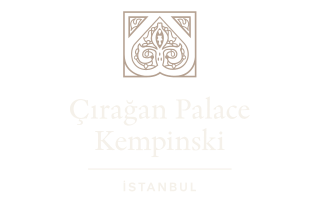
Çırağan Palace, a former Ottoman palace, is now a five-star hotel in the Kempinski Hotels chain. It is located on the European shore of the Bosporus, between Beşiktaş and Ortaköy in Istanbul, Turkey.
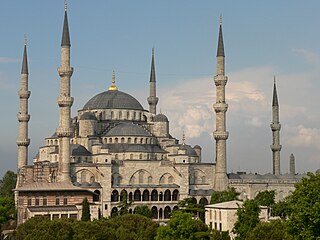
Ottoman architecture is an architectural style or tradition that developed under the Ottoman Empire over a long period, undergoing some significant changes during its history. It first emerged in northwestern Anatolia in the late 13th century and developed from earlier Seljuk Turkish architecture, with influences from Byzantine and Iranian architecture along with other architectural traditions in the Middle East. Early Ottoman architecture experimented with multiple building types over the course of the 13th to 15th centuries, progressively evolving into the classical Ottoman style of the 16th and 17th centuries. This style was a mixture of native Turkish tradition and influences from the Hagia Sophia, resulting in monumental mosque buildings focused around a high central dome with a varying number of semi-domes. The most important architect of the classical period is Mimar Sinan, whose major works include the Şehzade Mosque, Süleymaniye Mosque, and Selimiye Mosque. The second half of the 16th century also saw the apogee of certain decorative arts, most notably in the use of Iznik tiles.

The Balyan family was a prominent Armenian family in the Ottoman Empire of court architects in the service of Ottoman sultans and other members of the Ottoman dynasty during the 18th and 19th centuries. For five generations, they designed and constructed numerous major buildings in the Ottoman Empire, including palaces, mansions, konaks, kiosks, yalis, mosques, churches, and various public buildings, mostly in Constantinople.

Ortaköy Mosque, formally the Büyük Mecidiye Camii in Beşiktaş, Istanbul, Turkey, is a mosque situated at the waterside of the Ortaköy pier square, one of the most popular locations on the Bosphorus. It was commissioned by the Ottoman sultan Abdülmecid I and its construction was completed around 1854 or 1856.
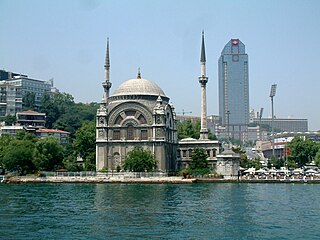
Bezmiâlem Sultan, called also Bazimialam Sultan, was a consort of Sultan Mahmud II, and Valide sultan to their son, Sultan Abdulmejid I of the Ottoman Empire.
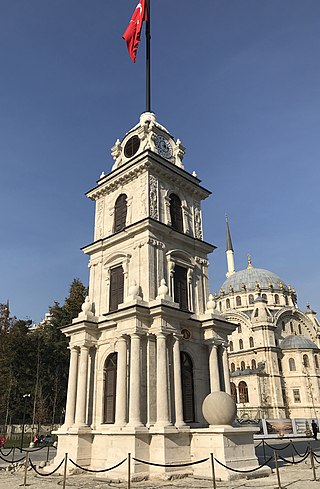
Nusretiye Clock Tower, aka Tophane Clock Tower, is a clock tower situated at Tophane, a neighborhood in Beyoğlu district of Istanbul, Turkey, next to Nusretiye Mosque and Tophane Kiosk at the European waterfront of Bosphorus. It was ordered by the Ottoman sultan Abdulmejid I (1823–1861), designed by architect Garabet Amira Balyan and completed in 1848.
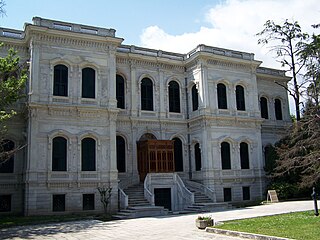
Yıldız Palace is a vast complex of former imperial Ottoman pavilions and villas in Beşiktaş, Istanbul, Turkey, built in the 19th and early 20th centuries. It was used as a residence by the sultan and his court in the late 19th century.

The Teşvikiye Mosque is a neo-baroque structure located in the Teşvikiye neighbourhood of Şişli district in Istanbul, Turkey.

The Pertevniyal Valide Sultan Mosque, also known as the Aksaray Valide Mosque, is a grand Ottoman imperial mosque in Istanbul, Turkey. It is located at the intersection of Ordu Street and Atatürk Boulevard in the Aksaray neighborhood beside the Pertevniyal High School which was also built by the order of Sultana Pertevniyal in 1872. The mosque attracts 400-500 worshipers during regular prayer times and over 2,500 worshipers during Friday prayers.

The Dolmabahçe Mosque is a baroque waterside mosque in Kabataş in the Beyoğlu district of Istanbul, Turkey, close to the Dolmabahçe Palace. It was commissioned by Queen Mother Bezmialem Valide Sultan and designed by the Turkish Armenian architect, Garabet Balyan in 1855. After his mother's death, Sultan Abdülmecid saw the building work through to completion.

The following outline is provided as an overview of and topical guide to the Ottoman Empire:

The following outline is provided as an overview of and topical guide to Istanbul:

Ottoman Baroque architecture, also known as Turkish Baroque, was a period in Ottoman architecture in the 18th century and early 19th century which was influenced by European Baroque architecture. Preceded by the changes of the Tulip Period and Tulip Period architecture, the style marked a significant departure from the classical style of Ottoman architecture and introduced new decorative forms to mostly traditional Ottoman building types. It emerged in the 1740s during the reign of Mahmud I (1730–1754) and its most important early monument was the Nuruosmaniye Mosque, completed in 1755. Later in the 18th century, new building types were also introduced based on European influences. The last fully Baroque monuments, such as the Nusretiye Mosque, were built by Mahmud II in the early 19th century, but during this period new European-influenced styles were introduced and supplanted the Baroque.

This article covers the history of Ottoman architecture from the 19th century up to the end of the Ottoman Empire in the early 20th century. The 19th century saw architectural influences from Western Europe increase. The Ottoman Baroque style, which emerged in the 18th century, continued to be evident in the early 19th century under the reigns of Selim III and Mahmud II. Empire style and Neoclassical motifs also began to be introduced around this time. Subsequently, a trend towards eclecticism became prominent in many types of buildings, particularly during the Tanzimat period, as exemplified by the Dolmabaçe Palace and other mosques of this era designed by architects of the Balyan family.